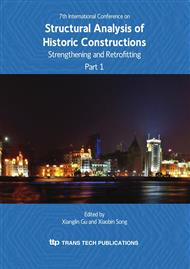p.703
p.709
p.715
p.721
p.727
p.735
p.741
p.747
p.753
The Intervention of Earthen Heritage in Seismic Areas and the Conservation Charters
Abstract:
Earthquakes are recurring natural phenomena that cause cumulative damage to earth constructions that can lead to their collapse. The discovery of earthen architectural heritage in Peru, has led to the re-exposure of adobe buildings, increasing their vulnerability to seismic activity. How can we prevent protect them from further damage their loss and Due to their gradual and progressive destruction, earth constructions located in seismic areas constitute a critical and unique case. The structural response of stone masonry joined with mud mortar depends on the weakest of their construction materials: earth. This paper presents the criteria for structural conservation of earthen architectural heritage and tools for seismic-resistant reinforcement developed by field experts during the last 25 years. The concepts of reinforced earth and liquid mud injection, developed by the Pontifical Catholic University of Peru (PUCP) with support from the Getty Conservation Institute (GCI), are also included in this work. The article also analyzes recent cases of the re-intervention of earth monuments initially restored during the last century and re-destroyed by more recent earthquakes; offers solutions to this situation, ranging from the safest and friendliest to the most aggressive ones. Finally, I concludes expressing the urgent need to reassess the conservation criteria accepted by the International Charters ratified by ICOMOS and UNESCO regarding earthen architectural heritage located in seismic areas.
Info:
Periodical:
Pages:
727-734
Citation:
Online since:
October 2010
Authors:
Keywords:
Price:
Сopyright:
© 2010 Trans Tech Publications Ltd. All Rights Reserved
Share:
Citation:



